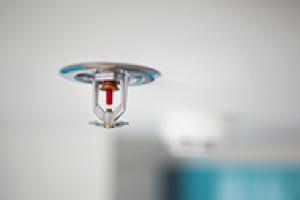Bringing facility systems together
The rate of health care mergers and acquisitions (M&A) has increased significantly, with 95 or more hospital transactions occurring in the United States each year from 2012 through 2014, according to an analysis by Kaufman, Hall & Associates.
In fact, last month’s Health Facilities Management/American Society for Healthcare Engineering (ASHE)/Association for the Healthcare Environment Salary Survey found that nearly one-third of respondents work at a facility that has been involved in M&A activity over the past three years.
You may also like |
| Infrastructure planning for off-site operations |
| Benchmarking energy performance |
| Benchmarking chiller and boiler efficiency |
| |
Facility managers who have not yet participated in a merger or acquisition should be prepared to do so and be change leaders in their organizations, advises Leo M. Gehring, CHFM, CHC, FASHE, the 2007 president of ASHE and a consultant based in Little Rock, Ark.
“The No. 1 thing facility managers need to learn is that mergers and acquisitions happen for positive reasons, not for negative reasons,” Gehring emphasizes. Facility directors with a track record of championing efficiency, financial responsibility, and patient safety and satisfaction in their organizations will be positioned to thrive after the announcement of a merger or acquisition and be better able to adapt to new procedures and standards, he says.
What to expect
Change after a merger or acquisition is inevitable, but it doesn’t happen overnight. When rapidly growing Geisinger Health System acquires a hospital or health system, new signage will be in place on the first day the health facilities are officially part of Geisinger. But it can take more than a year to bring the acquired organization’s information technology (IT) systems up to speed.
“The first task when absorbing these organizations is to get the IT converted to our IT systems,” says Al Neuner, CHFM, vice president of facilities operations for Danville, Pa.-based Geisinger, which has nine hospital campuses in Pennsylvania. “Sometimes we’re a year or two down the road before we can roll out all of our programs, including our maintenance management systems, our building database systems, and our policies and procedures, because we don’t have the organization’s IT on our network yet.”
During periods of waiting or uncertainty after a merger or aquisition announcement, facility managers should step up to the plate and demonstrate their competence and knowledge of the business of health care, urges Gehring, who has 45 years of experience in health facilities management. “We need to get away from the boiler house mentality — the assumption that if we know everything there is to know about boilers, we’ll be perceived as winners and be successful in our careers,” he says.
Assessing the situation
When Englewood, Colo.-based Catholic Health Initiatives (CHI), which owns and operates 105 hospitals in 19 states, acquires a hospital or health system, the organization conducts a total quality evaluation of the newly added facilities, says George A. “Skip” Smith, CHFM, SASHE, CHI’s vice president of physical asset services.
“We go in and assess the entire program, including the operations and the competencies of staff,” says Smith, who was ASHE’s 2011 president. “We review their capital budgets. And we go through every one of the Joint Commission’s standards and make sure the facilities are compliant.”
After the first evaluation, facility directors have 18 months to fix any problems under their jurisdiction. “Our evaluation is scored on a scale of 1 to 100,” Smith explains. “If they get a 60 the first time, we expect that the next time, they will be over 90.
“We don’t penalize them the first time because often they don’t have the experience, the training or the resources,” he continues.
Smith notes that CHI will provide assistance to underperforming facilities, such as bringing a top-notch facility director from another site to help out, providing management plans and other templates, and reviewing potential plans before their implementation. “They will get resources they didn’t have before,” he says.
When a robust health system purchases a struggling hospital or group of hospitals, facility managers at the acquired institutions should anticipate that more attention will be paid to environment of care and infection control standards, Gehring says. That added scrutiny should be viewed favorably, he maintains.
One potential target for close inspection after a merger or acquisition is air flow, which is critical to preventing health care-associated infections. Gehring points out that the Joint Commission recently has been focusing on improving compliance with isolation room air-pressurization standards, which more than half of its accredited hospitals fail to meet.
Patients with highly infectious diseases should be in negatively pressurized rooms to prevent pathogens from escaping, whereas immunocompromised patients should be in positively pressurized rooms to keep contaminants away. Although facility managers should be familiar with these basic principles, they frequently do not effectively monitor air pressure, Gehring contends.
“Right now, 53 percent of hospitals are getting findings on that,” he says.
Gehring suggests that a simple Baulin tube inserted in the wall would make it easy for staff to visually determine whether a room is appropriately pressurized. More elaborate pressure monitoring and alarm systems can be implemented as well.
Factoring in cost
After patient safety and health, cost reduction at newly acquired facilities takes top priority. One of the first operational changes Geisinger expects of acquisitions is a focus on energy management. “Our experience typically is that we can reduce their energy costs in the first two or three years from somewhere around $5 a square foot down to $3 a square foot,” Neuner says.
Geisinger has a three-pronged strategy for decreasing energy expenditures: leverage its buying clout to make better energy purchases, improve efficiency and upgrade outdated equipment.
“The first way to reduce energy costs is to buy better,” Neuner says. “We have contracts with energy brokers, so the way we purchase power is generally different from the way our acquisitions have done it in the past. We can usually reduce their utility costs by 10 percent just through our purchasing agreements.”
Second, Geisinger expects all of its hospitals to benchmark their energy usage and identify and rectify inefficiencies. “For example, a facility may be running 40-degree chilled water where it only needs to be 42 degrees,” Neuner says. “By going in and tuning up systems, we can gain another 10 percent in cost savings.”
Finally, Geisinger will make capital investments where indicated. “Chances are the acquired facilities are operating chillers and boiler plants that are well in excess of 30 years old and sometimes in excess of 50 years old,” Neuner says. “When we replace old equipment with systems that are much more efficient, that accounts for the majority of our energy cost savings.”
As when negotiating with utilities, large health systems are able to obtain better pricing on equipment and other purchases than smaller organizations can. Typically the toughest adjustment for facility directors in the wake of a merger or acquisition is the loss of purchasing autonomy, notes Smith.
“In a lot of markets, they like to be able to go to Fred’s Hardware and buy from Fred, whom they’ve known for years,” he says. “Usually, it’s just convenient for them. But we have national agreements driving pricing that we expect they will participate in.
“Having been a facility director, I know that when you’ve not done this before and you’re asked to do it, it’s not fun,” Smith continues.
At Geisinger, newly acquired hospitals also are expected to purchase equipment from specific vendors, though buying a gallon of paint or a bucket of bolts from the local hardware store is not considered a big deal, says Neuner. Some flexibility is allowed to meet pressing needs and maintain relationships.
Because environmental services departments consume a lot of products and have a variety of contractual agreements, Geisinger environmental services managers generally must take advantage of negotiated pricing discounts, points out Bruce Thomas, the health system’s vice president of guest services.
“The big advantage of mergers and acquisitions is the ability to capitalize on volume purchasing,” Thomas says. “In environmental services, if there is not a written contract that we have to wait out, we’ll bring new facilities up on our hand sanitizer program, we’ll bring them up on our recycling program, and we’ll bring them up on our outsourced linen program. This doesn’t necessarily happen on Day 1. But our intent is to have everybody participate in these programs, because that’s where the savings start to come in.”
Maintaining consistent ES quality
When one health system acquires another, it can take years before environmental services departments become standardized, because many hospitals and small health care organizations outsource housekeeping, and existing contracts generally need to be honored. Such was the case when UCLA Health acquired Santa Monica Hospital, says Arturo Sanchez, the Los Angeles-based health system’s administrative director for environmental services.
Five or six years passed before all of the Santa Monica campus’s environmental services functions could be integrated, he recalls.
UCLA Health prefers to insource housekeeping because it plays an important role in supporting the health system’s patient-centered brand, Sanchez says. He notes that the hospitality industry heavily influences the way his housekeepers are expected to communicate with patients.
“Our housekeepers act more like ambassadors and interact and connect a lot more with our patients than they used to in the past,” he says.
At all UCLA Health hospitals, housekeepers must knock on a patient’s door and request permission to enter before going into an occupied inpatient room. They greet the patient warmly, introduce themselves and explain what they are going to do, asking if it’s OK to begin their cleaning tasks. Afterward, they connect with the patient again, asking whether anything else is needed.
“They make sure that everything is up to the satisfaction of the patient,” says Sanchez, noting that housekeepers must leave on the bed table a Post-it note with their name and a contact number should the patient have additional requests later on. “Then they exit with courtesy, thanking the patient and wishing him or her a good day,” Sanchez explains.
When health systems have multiple hospitals, practices can be pilot-tested at one facility before being rolled out to the rest, Sanchez says. For example, at UCLA Health, housekeepers fold the leading end of a new toilet paper roll into a “V” and affix a gold seal to indicate that it is fresh and safe to use. And they place a band around the seat of just-cleaned and sanitized toilets. “These practices were piloted at a few units in Santa Monica before becoming systemwide,” he says. “We’ve seen an improvement in our quality scores as a result.”
Functioning facilities
After a merger or acquisition, functions often become consolidated and space is repurposed. Health systems frequently make renovations to create a consistent identity across all facilities and meet organizational standards for patient care. But this doesn’t occur immediately or universally. Expected return on investment weighs heavily in decision-making.
“For our smaller hospitals at very rural sites, for example, we’re not likely to spend $5 million to renovate inpatient spaces because there is little or no chance that those facilities will increase their patient volume as a result,” says Neuner. “They would simply be saddled with that depreciation as an added expense.”
Geisinger’s first goal is to make new acquisitions profitable and self-sustaining. “Once we do that, we can take the next step,” Neuner says.
CHI typically does not make a lot of visible changes to the facilities it acquires. “Our branding has more to do with how patients are treated,” Smith says.
When they first learn that their institutions are being acquired by another organization, many facility and environmental services managers have misgivings. They may worry about their job security or the burden of learning new policies and procedures.
“There is a lot of fear of the unknown,” Thomas says. “We try to settle those fears down as much as possible. But anytime you’re dealing with an acquisition, some people are intimidated.”
Many facilities managers are delighted to become part of Geisinger, while some choose to resign, adds Neuner. “There are those who embrace change, and there are those who are offended by it,” he says. “The latter tend to leave on their own volition in the first year or so.
“We never terminate anyone,” Neuner continues. “It just seems to sort itself out.”
Change is constant
In the current health care climate, change is constant, and no health care leaders are confident of what the future may bring, observes Rosalyn Cama, FASID, EDAC, whose New Haven, Conn.-based firm specializes in evidence-based health care design. She argues that the challenges faced by facilities going through mergers or acquisitions really are no different from those that health care institutions are confronting right now.
“They are asking the same questions,” she says. “Who are we? How can we deal with the ever-changing market and health care transformation? How do we improve patient care and comfort?”
To be successful today, facility directors need to understand the big picture of health care and their role in improving patient outcomes and reducing costs, notes Gehring.
“Before a merger or acquisition is impending, we need to take the lead on patient safety and satisfaction,” he says. “We need to understand why we do what we do and make sure we are doing it as efficiently as humanly possible.”
Carolyn Schierhorn is a Wheaton, Ill.-based freelance writer who specializes in health care and construction topics.
Branding post-acquisition renovations
More than 60 percent of hospitals and health systems undergoing consolidation will renovate facilities in the next two years, according to the 2015 Construction Survey conducted by Health Facilities Management and the American Society for Healthcare Engineering. Rebranding drives a large proportion of post-acquisition interior upgrades, says Ana Pinto-Alexander, IIDA, EDAC, principal and senior vice president of HKS in Indianapolis.
“The nature of the renovation depends partly on whether the acquiring organization is a ‘branded house’ or a ‘house of brands,’ ” she notes.
A branded house, such as Apple Inc. or Cleveland Clinic in the health care realm, has a strong organizational identity and consistent products and services, Pinto-Alexander explains. A house of brands, in contrast, is a collection of strong brands that individually are better known than the parent organization. Just as Johnson & Johnson comes to mind in consumer products, Ascension Health, the nation’s largest nonprofit health system, is an example of a house of brands, she says.
St. Louis-based Ascension, a client of hers, has many standards that must be followed in renovations, but they tend to be related to cost savings, and patient comfort, health and safety, as opposed to requiring a specific color palette.
“Ascension has done a lot of research to create standards for the best care,” Pinto-Alexander says. “They have specifications for minimum room sizes, designate manufacturers we must order from, require that only non-harmful products be used and disallow anything that would appear wasteful and extravagant, such as fancy decorative ceiling tile or carpeting in patient corridors. They don’t want to be perceived as having spent too much money on facilities because people may think that’s why health care is so expensive.”
Another of her clients, Indianapolis-based Indiana University (IU) Health is a branded house that specifies in more detail how its facilities should look and operate, from the color of counters to the positioning of reception desks and kiosks.
“At IU Health, receptionists, no matter where they are, have to wear a uniform that includes a white shirt and navy blue sweater,” she notes. “They even brand the people.”



